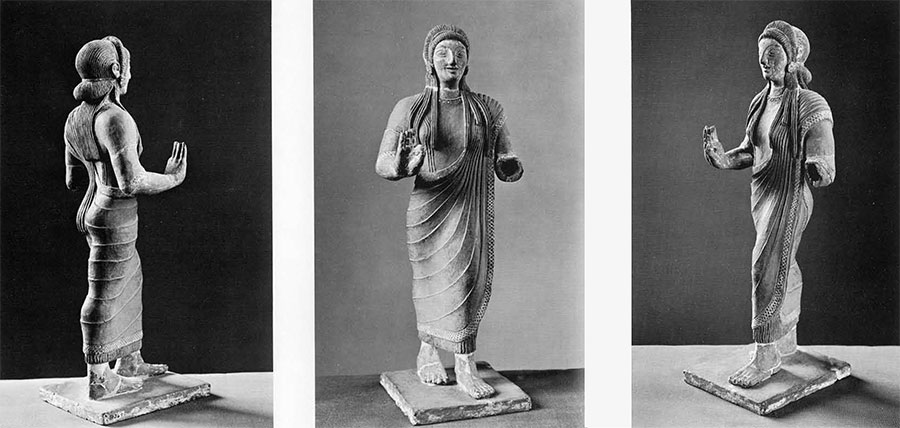
On the shelves of the classical study-storage a remarkably beautiful terracotta figurine has stood for many years. The figure is that of a maiden resembling a Greek kore in a sleeved chiton and a himation, and with one foot placed ahead of the other. Her right hand could once have held a flower, or perhaps an egg, and her left, also extended forward, preformed some action unknown to us because of a break which occurs below the elbow. Her general posture, drapery-lines, and contours of body and face, ought to date her between 510 and 490 B.C.
She was sent to the Museum on approval in 1950 by Mr. T.S. Quinn of Lebanon, Pennsylvania. Mr. Quinn had bought her from Mr. Quinn had bought her from Mr. Piero Tozzi, an antiques dealer in New York City who said she had come “from near Orvieto” in central Etruria, and both these gentlemen presumably believed in her excellence and authenticity.
When she first arrived in the Museum she was accompanied by papers furnishing chemical analyses of the white paint-like slip which still adheres to parts of her face, her jewelry, and the borders of her garment; of the red of the himation, and the black substance on the headdress. These had been completed in 1938 and 1939 by Dr. R. J. Gettens, then of the Mallinckrodt Chemical Laboratory, Cambridge, Massachusetts. Forming part of her dossier was a petrographic examination of the clay by Harry Berman of the Harvard University Department of Mineralogy and Petrography. In these analyses the investigators used as comparative material samples from two Etruscan terracotta antefixes (end cover-tiles) in the collections of The Museum of Fine Arts, Boston, and from the smaller of the then newly acquired and very famous terracotta warrior figures in the Etruscan gallery of The Metropolitan Museum in New York. In general it may be said that the results showed the materials of all these figures to be similar, as all contained diopsidal pyroxenes typical of Vesuvian lavas, or rather, of earth from magmas derived from the disintegration of lavas of Vesuvian type. It was determined that the structures of their clays were not much changed from that of original natural samples, or from each other, in the process of shaping and firing.
The white material from the face and borders was found to be homogeneous and principally calcium fluoride of natural, not artificial, origin, derived from the grinding of fluorite. The white substance from the other Etruscan objects tested was found not to be calcium fluoride. The black material from the headdress was found to be a mixture of carbon-black with the same white material, calcium fluoride, mentioned above. The red material from the lower areas of the skirt is chiefly oxide of iron, like red ochre. Lumps of earth-like material retained in the hollow interior of the statuette were shown to be clay which contained silica and common earthy minerals, such as might have been in the earth in which it was buried.
The results of all these careful chemical and petrographic analyses, and their comparisons with some other authenticated Etruscan pieces, placed out statuette well within the possibility of having been made in Italy, even in Etruria. This much chemistry and petrography are able to tell us, but it is not nearly enough. Unfortunately they can not touch upon the matter of authenticity; that is, they cannot place any chronological limitation whatever upon the origin of the figurine.
So, although its chronology was still left debatable and although some experts had given us the scarcely comforting advice that perhaps genuinely ancient arms, legs and base may have been affixed to a modern head and body, the figurine, the kind gift of Mr. Quinn, was accepted by the Museum and accessioned as 50-36-1.
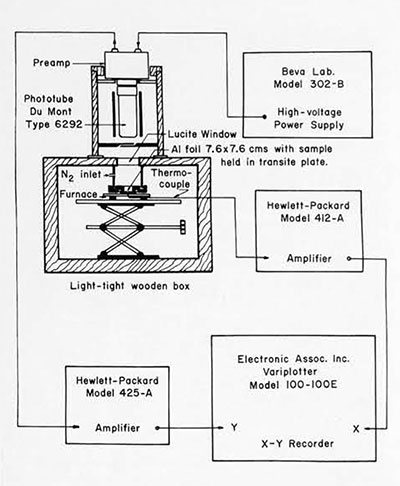
As soon as the statuette was placed on exhibition in her own case in the then newly refurbished Etruscan gallery, she naturally drew the attention of all comers. Among the visitors to the gallery were some people who were very worth indeed to be judges of her qualities.
Here are some of their opinions, left indelibly printed in the memories of the curators of the Mediterranean Section. At least two, magically gifted art-historians who possess a rare “gefuhl” for style, could say, “I don’t like her,” and of course they did not have to say why. Another objected with some vehemence to the hair-style, which indeed seems to be a first known occurrence of this method of filleting with chignon and full hair-fall in back, and separated tresses straying down the front. Another objection which seemed formidable at the time was that the scale was wrong. The size of the statuette (height 39.4 centimeters) falls awkwardly between those of the larger and the smaller ones we know. Still another visitor came up with the shattering discovery that the lines which indicate the direction of the draped fall of the chiton across her right shoulder seem to get lost (as indeed they do), and that therefore this must be the work of a modern copyist. One commentator remarked that the presence of such a small thin plinth was wrong— that such bases are not to be found on other known (larger or smaller) terracottas.
After listening with increasing confusion to this barrage of comment which was being added to their own mixed opinions, the staff of the Mediterranean Section elected to remove the statuette from exhibition. And lately, during the years that she has rested in storage a few visitors have come along and frankly wondered at us for keeping her hidden away on the study shelves. Obviously, however, the arguments pro and con had been unanswerable and so the matter remained at an impasse—until a few months ago.
During a casual conversation with Miss Elizabeth Ralph, the Associate Director of the Applied Science Center for Archaeology, here in the Museum, the subject was led round to the progress now being made in the practical application of thermoluminescence to the dating of terracotta. Why not, indeed, try to make use of our own modern laboratory apparatus and know-how to solve a very special problem in our own building? We decided, and Dr. Rodney Young, the Curator of the Mediterranean Section, agreed, that samples might be taken from the figurine for a dating test.
The process is based on the fact that many minerals, subjected to natural radiation from their own trace elements such as uranium and thorium, emit energy in the form of light when stimulated by heat. This is the result of the bombardment by alpha- and beta-particles upon the other constituents. For instance, irradiated crystals of calcite emit “cold light” visible to dark-adapted eyes even at room temperatures. At temperatures of 200 to 300 degrees Centigrade the glow is bright enough to be photographed in color. But what is most important for us is the fact that if this glow is once driven off by heating and if the mineral is not redosed by artificial irradiation, the glow will not be replaced except by the slow process of natural re-dosage.
So it is with clays. The firing of a pot by ancient man provides a clean beginning date for the slow re accumulation of this measurable energy. When terracotta exhibits a glow curve, one knows that some time has elapsed since it was fired. But a complete age determination is dependent upon several factors: the light emitted, the rate of bombardment by the inherent radioactive elements, and the susceptibility of the material to radioactivity.
The apparatus necessary for such age determinations and the calculating of the results of testing belong to the world of Miss Ralph and her Research Chemist, Mr. Mark C. Han, upon both of whom I rely for the technical portions of this paper. A block-diagram of the glow-curve apparatus (used for one phase of the determination) is illustrated. The results are plotted by the x-y recorder upon which the light output is shown on the y-axis and the temperature on the x-axis. Such curves appear in the illustrations and they will be cited individually as we try to keep abreast of the adventures which befell our Etruscan statuette.
First of all let us illustrate the recorded curve belonging to an object with normal inherent radioactivity which has been fired in recent times, as for instance a very modern pot. This is presented in Curve 1-A, where light output is detected only above 450 degrees Centigrade, at a point where the extreme heat makes the whole furnace red hot—like the walls of an overheated stove. Any terracotta sample refired immediately after having been fired produces this curve since there is no longer any thermoluminescence remaining in it; this is called the “background” curve of the sample. On the other hand, the curve representing thermoluminescence accumulated truly by age begins to rise at above 200 degrees and normally gives a result similar to the Curve 1-C.
This part of the measurement can be performed with a very small sample, but, unfortunately, for a complete age determination, at least three grams must be taken. This fairly large sample is needed to determine the rate of bombardment which is proportional to its alpha content. After the sample is powdered and measured in an alpha-counter, part of the same three grams may be used for the measurement of the natural glow curve and for determining the amount of correction for the susceptibility of the particular clay to radioactive bombardment; this is done artificially, with X-rays.
The taking of such a large sample, however, poses a problem when there is hope that an object may be exhibited and therefore must not be damaged. We therefore decided, at first, to rely upon a short-cut method—to measure only the natural glow curves of very small samples from various parts of the figurine. Minute scrapings were taken from hidden areas—under an ear, inside the hollow arm, under the skirt, and from underneath the plinth. These, totaling a few milligrams, were ground and “dusted” on the glow-pan. We were excited to find that there was light-output (Curve 1-B) from all these undersized samples, which was a basic indication that some time had elapsed since she was fired. We were encouraged also because the curves from each part were similar, indicating that she was not a pastiche of ancient and modern parts.
The results from the small samplings and the “dusting” method gave an indication of antiquity (as we shall learn later, a misleading one) but no quantitative measure of age. Since we had not solved the age problem, we decided to take a slightly larger sample from underneath the plinth and to make a standard determination of the natural and artificial glow curves. But at this stage we were still reluctant to take the whole amount required for the radioactivity measurement, and though that we could safely apply an average value for it, obtained from an alpha count done on another Etruscan terracotta head (34-23-1) in our gallery. Therefore, for our quantitative measurement, small borings were made by hand-drilling underneath the plinth of the statuette. From our sample it was possible to make twenty replicate mountings for the measurement of both the natural and artificially-dosed glow curves. Curves 1-C and 1-D are examples of the twenty measurements of the natural glow curves; 1-E is an average of the artificial curves.
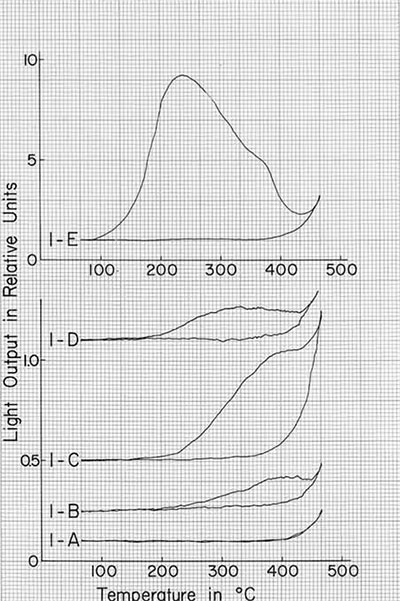
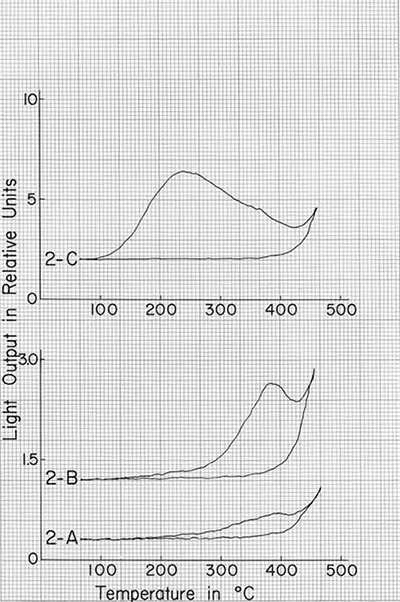
To interpret curves of this nature, the area between the thermoluminescence curve and its background curve must be calculated. The area of the natural glow curve gives an indication of the age of the object. Then a correctional factor derived from the artificial curve is applied. The object of the latter is to correct for deviations due to varying susceptibilities to bombardment among the replicate runs of the natural glow curves (not the difference between curves 1-C and 1-D), but in this case, the statistical deviation was not reduced significantly as it had been for other samples measured previously in the laboratory. Therefore, even if its inherent radioactivity had been known to us at this time, the age could be quoted only with a much larger tolerance than usual. Specifically, from the relationship between the natural and artificial curves and a guess that its inherent radioactivity was normal (ten alpha counts per hour, assumed from the count on 34-23-1 and on many classical potsherds), we estimated that the age-range of the Etruscan statuette was between 780 B.C. and A.D. 300.
Just to take care of all doubting Thomases (and would we had been such ourselves), a second classical statuette of very different type which had never been considered a fake, presumably also of Italian clay and of the same supposed age-range (ca. 510-500 B.C.) was put through the “short” and “long” processes. The samples from this seated goddess (50-14-3) yielded the glow curves 2-A and 2-B. The area of 2-A is slightly different from that of 1-C, but both curves have peaks above 300 degrees Centigrade which normally indicates that the specimen has survived through many years at earthly degrees of temperature and has only now parted with its stored-up energy.

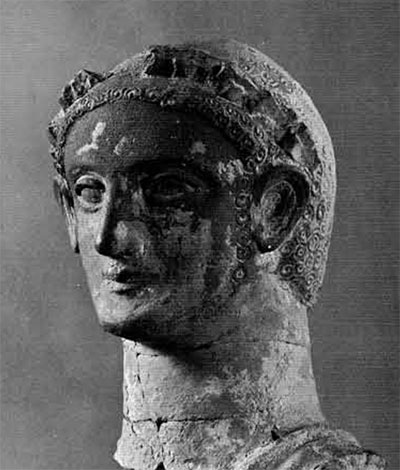
We had thus almost convinced ourselves that an important part of the age determination—the alpha count—could be estimated rather than actually measured when it was suggested that we test a sample from one of the Etruscan warriors in The Metropolitan Museum—the same ones which had been petrographically analyzed in 1938-39. A three-gram sample from the largest (Met. Mus. Acc. 21.195) was generously provided by Mr. Joseph V. Noble and we discovered, to our dismay, that it had an extremely high alpha count—80 counts per hour. Also, the glow curves were atypical in two respects. First, the peaks of the natural curves appeared at a lower temperature than normal (close examination of Curves 1-C and 1-D shows this difference to a lesser extent). This provides a hint that these objects have not been subjected to ambient temperatures for very long periods of time. Second, the statistical deviation of the ratio of the warrior’s natural and artificial glow curves was much greater than usual—the same problem which was earlier encountered in the case of our statuette.
We realized then that we had to measure the inherent radioactivity of our 50-36-1. We therefore extracted from beneath her plinth the requisite three grams. We mounted this sample on the zinc sulfide screen of our alpha counter, turned on the scaler, and the lights danced—90 counts per hour. It contained almost ten times greater than normal radioactivity and as a result, its age must be only one-tenth of that originally estimated. In fact she had to be modern.
The one possible loophole remaining was the fact that the plinth might be more radioactive than the body. Therefore we took our courage in our hands and thinking that after all she had been broken and mended with plaster in many places before she came to us, we chipped away three grams from inside and around the outer end of the broken arm. Again, the counter clicked rapidly—90 alpha counts per hour. Also, the deviation of the glow curves was even more severe than that for the plinth and the peaks appeared at lower temperatures.
There is no question now that we were misled by our first “shortcut” tactics, but we have learned a lesson from this: namely, that no measurement is ever to be considered complete without the accompanying, modifying, information to be derived from a measurement of the sample’s inherent radioactivity.
With mixed feelings we place our statuette back in storage labeled surely a forgery. Thus she joins in limbo the Etruscan warriors in The Metropolitan Museum. To all the original critics of her genuineness, congratulations, and to the terracotta-forgers still loosing their spurious wares on the world, thermoluminescence issues an ultimatum.
